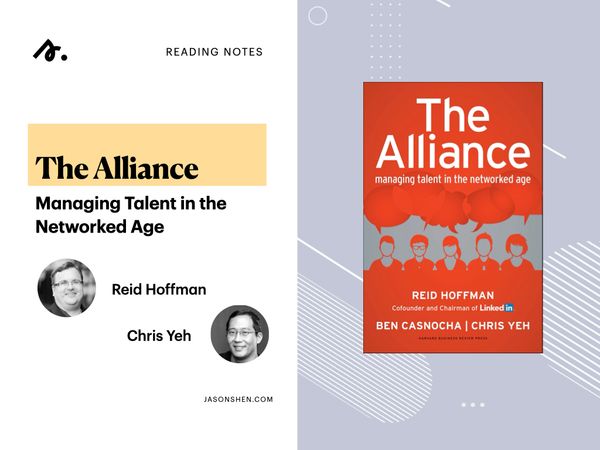My reading notes The Alliance: Managing Talent in the Networked Age by Reid Hoffman, Ben Casnocha and Chris Yeh.
This is a book about rethinking the relationship between employees and employers. I’d say the audience is primarily executives and managers, well as HR leaders. Both as an employee and as a founder, I found it an interesting read. It’s a fairly quick read, which is nice as most business books drag out their ideas for far too long. There’s also a companion website that allows people to follow up and learn more about their ideas.
In a Nutshell
Over the past 50 years, the relationship between employers and employees has shifted dramatically, from “a lifelong job for lifelong loyalty” to “you could be fired at any time for any reason”. This approach, driven by corporations trying to improve their bottom line in the short term, has cost them dearly in the long run because it has lead to a very mercenary, “I work for the highest bidder” mentality among employees. They envision a new kind of relationship for employers and employees based on mutual trust & benefit and open communication that they call “the alliance”.
Key takeaways
1. Companies are more like professional sports teams than families
The authors reference Netflix’s culture document which said that they aren’t a family, they’re a professional sports team. You’re supposed to love your family no matter what but pro athletes get cut, traded, paid unequal amounts, etc. Let’s stop pretending people are going to work at your firm forever. Great employees get poached all the time, and underperforming ones get cut. The average American held 11 jobs over 40 years, meaning they switch every few years. I’ve had 21 paying jobs myself…
2. Explicitly define tours of duty (with a mission and an end date)
So if people aren’t going to be there forever as we also don’t want a super mercenary quid pro quo culture, what are we to do? The authors have drawn inspiration from the military, borrowing the concept of a “tour of duty”. They describe 3 types of tours – rotational tours of 1-2 years for entry level candidates, transformational tours of 2-4 years with specialized projects/efforts for mid level candidates, and foundational tours lasting 10+ years, which feature deep, “founder-level” contributions for senior/executive level candidates.
A mission for a transformation tour might be: build out a proven, scalable system for launching in our service in a new city. Lead a cross-functional team to raise net promoter score by 30%. Launch a new product and get it to $X million in annual revenue. Big, meaty challenges that significantly impact the business.
These tours of duty create a predefined end date, which allows both the employee and the employer to plan ahead and reduce uncertainty. It also allows employees to be more honest about their goals and values — typically employees have to pretend like they never have aspirations beyond the company, but the tour reduces that feeling. This also allows the company to deepen its value for the employer by offering training & opportunities that further the person’s entire set of goals. As the tour comes to a close, both parties can have a conversation about whether they want to renew for a new tour or possibly move elsewhere with no hard feelings.
3. Network intelligence – an underleveraged opportunity
Information and insights — whether about customers, market trends, competitors —are crucial to a company’s success and can be a competitive advantage. According to the authors, most firms underuse their greatest assets for collecting information and insights: their employees. You should encourage employees to go out for lunch with peers in the industry and go to conferences and bring back that important knowledge back into the firm. Great employees are already going out and networking and getting these insights and the authors argue that if you simply create a small “networking budget” for them, they’d be happy to share those inserts with the entire firm and the benefits are far greater than whatever cost you might incur.
I think this is absolutely a great point: in medium and large (100+ person) companies there’s a tendency to only spend time with other people inside the company, which leads to insular, groupthink mentality. Because I’ve spent most of my career in start ups and small companies, I’ve been forced to go out and meet other people in my industry and learn new things, which it made me far smarter and far more effective in the jobs that I’ve had.
—
Well that’s a quick look at The Alliance. The book includes details on how to institute a tour of duty system, the value of developing an corporate alumni association, and a lot of great stories of how people have managed and develops their careers in Silicon Valley with this tour of duty mentality and approach.

